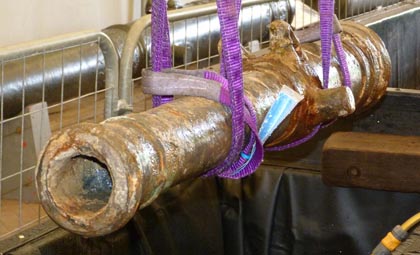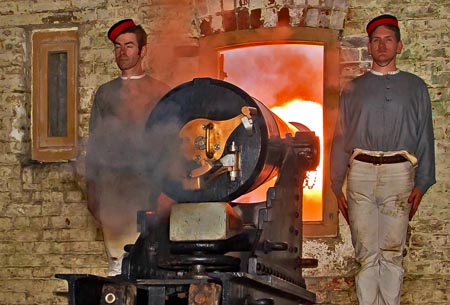Fort Nelson Portsmouth History

Visit Fort Nelson Museum, at Portsmouth, home of the Royal Armouries Collection and learn about the astonishing collection of artillery. It's a great day out with something for all the family to enjoy and discover.
Fort Nelson, located on Portsdown Hill overlooking the city of Portsmouth, was constructed between 1860 and 1871 as part of the Palmerston Forts a series of fortifications designed to protect key naval installations from the threat of French invasion under Napoleon III. Named after Lord Nelson, the fort was built as a large, heavily armed defensive structure intended to protect Portsmouth Harbour and the Royal Navy's dockyard.
Fort Nelson was part of a series of forts defending Portsmouth from a land attack including Fort Fareham, Fort Wallington, Fort Southwick, Fort Widley, and Fort Purbrook. Despite its formidable construction, Fort Nelson never saw combat, as the anticipated invasion did not occur. Over the years, its military significance waned with advances in military technology.
After World War 2 the fort was decommissioned and fell into disrepair. In the late 20th century, it was restored and is now managed by the Royal Armouries. Today, Fort Nelson operates as a museum, housing a vast collection of artillery and offering insights into the history of British coastal defences. The fort also serves as a venue for educational programs and historical reenactments.
What was Fort Nelson used for?
Fort Nelson at Portsmouth, was historically used as part of the defences for Portsmouth Harbour, to prevent a land based attack by the enemy. It served as a defencive fortification to protect the naval base, which was crucial for the Royal Navy during various periods of British history, particularly during times of conflict.
During World War 2 Fort Nelson was used for several key military functions:
- Ammunition Storage: The fort was used as an ammunition store, taking advantage of its robust construction and secure location. It's tunnels and magazines were ideal for storing large quantities of ammunition, particularly for the heavy artillery used to defend the coastline and Portsmouth Harbour.
- Anti-Aircraft Defence: With the threat of aerial bombardment by the German Luftwaffe, Fort Nelson played a role in Portsmouth's anti-aircraft defence network. While the fort itself did not have dedicated anti-aircraft guns, the nearby Portsdown Hill was strategically important for placing such defences.
- Military Communications: The fort was also used for military communications and as a command post. Its elevated position provided a good vantage point for monitoring and coordinating defencive operations around Portsmouth.
- Troop Accommodation: Fort Nelson housed troops and served as a base for various military units during the war. The fort's facilities, although outdated for modern warfare, were still useful for accommodating personnel involved in the defence of the region.
The Royal Armouries Museum
The Royal Armouries Museum was opened in 1984 for the first time, and today is one of the largest artillery museums in the UK. Although a cliche, the phrase 'must see' truly applies to Fort Nelson's astonishing collection of artillery and guns from different time periods. Over 700 items of artillery from many countries and spanning 600 years are brought to life whilst sensitively telling the unique stories behind them.
The Royal Armouries Museum at Fort Nelson showcases an extensive collection of artillery and military artifacts, with a strong focus on the history of artillery and fortifications. The museum's displays include a wide range of historic cannons and guns, spanning from medieval bombards to large naval guns, field artillery, and anti-aircraft weapons, illustrating the evolution of artillery technology. One of the museum's most famous exhibits is the Great Turkish Bombard, also known as the Dardanelles Gun, a massive bronze cannon cast in 1464.

The museum also honors military valor through its display of guns associated with Victoria Cross recipients, telling the stories of individuals who were awarded this highest military decoration in the British and Commonwealth forces. Visitors can explore the underground ammunition storage magazines, where they can learn about how ammunition was stored and handled during the fort's operational years. Interactive displays allow visitors to engage with the science and mechanics behind artillery, demonstrating how different types of guns were loaded, aimed, and fired.
Parts of Fort Nelson have been restored to show how soldiers lived and worked, including the barracks, mess areas, and the extensive tunnel network used for moving ammunition and supplies. The museum also hosts temporary exhibitions on various aspects of military history and regularly features reenactments, live firing demonstrations, and educational events. These displays provide a comprehensive view of the role of artillery in military history, from ancient times to the modern era.
Fort Nelson highlights:
- Free admission.
- Free parking.
- Daily gun firing 1pm.
- Visitor Centre - including Cafe 1871, which is open to passers-by and walkers.
- Explore eerie tunnels.
- State-of-the-art Education Centre - allowing children to see the past spring in to life in a historic setting, but harnessing the latest technology.
- Fort Nelson is licensed for weddings and has a large range of function rooms for private and corporate hire.
Fort Nelson Museum details:
- Fort Nelson, Portsdown Hill Road, Fareham, Hants, PO17 6AN
- Telephone: 01329 233734
- Fort Nelson Portsmouth opening times:
- Open every day except 24th, 25th and 26th December.
- Summer (April to October 10am - 5pm (last admission 4pm),
- Winter (November - March) 10am - 4pm (last admission 3pm).
- Admission is free, although there are admission charges for special events.
Fort Nelson Museum Portsmouth

